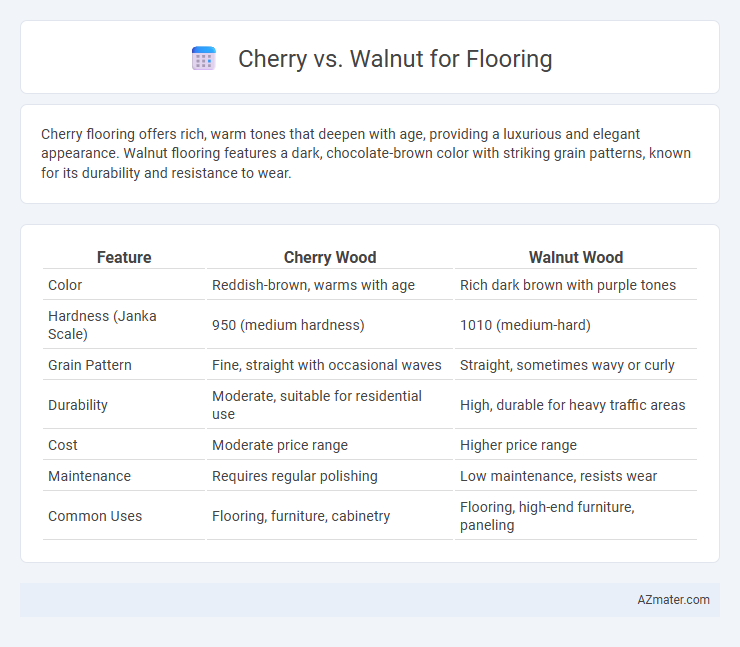Cherry flooring offers rich, warm tones that deepen with age, providing a luxurious and elegant appearance. Walnut flooring features a dark, chocolate-brown color with striking grain patterns, known for its durability and resistance to wear.
Table of Comparison
| Feature | Cherry Wood | Walnut Wood |
|---|---|---|
| Color | Reddish-brown, warms with age | Rich dark brown with purple tones |
| Hardness (Janka Scale) | 950 (medium hardness) | 1010 (medium-hard) |
| Grain Pattern | Fine, straight with occasional waves | Straight, sometimes wavy or curly |
| Durability | Moderate, suitable for residential use | High, durable for heavy traffic areas |
| Cost | Moderate price range | Higher price range |
| Maintenance | Requires regular polishing | Low maintenance, resists wear |
| Common Uses | Flooring, furniture, cabinetry | Flooring, high-end furniture, paneling |
Cherry vs Walnut Flooring: An Overview
Cherry flooring offers a warm, rich reddish-brown hue that deepens with age, creating a luxurious and elegant atmosphere ideal for traditional and classic interiors. Walnut flooring provides a darker, chocolate-brown tone with subtle grain patterns, lending a sophisticated and modern aesthetic suited for contemporary and rustic designs. Both hardwoods are durable, but cherry is softer and more prone to dents, while walnut provides better resistance to wear, making it preferable for high-traffic areas.
Wood Species Characteristics
Cherry wood flooring is valued for its rich reddish-brown hue and smooth grain that deepens in color over time, offering a warm, elegant aesthetic. Walnut flooring features a darker, chocolate-brown appearance with a straight grain and occasional waves, known for its natural durability and resistance to wear. Both woods provide strong stability and are moderately hard, but walnut is typically harder and more resistant to dents and scratches compared to cherry.
Color and Appearance Differences
Cherry flooring offers a rich, warm reddish-brown hue that deepens and develops a smooth patina over time, creating an elegant and classic look in interior spaces. Walnut flooring showcases a darker chocolate-brown color with subtle purple undertones and natural grain variations, providing a sophisticated and contemporary aesthetic. The color of cherry tends to brighten with light exposure, while walnut maintains a consistent deep tone, making each choice ideal for different design preferences and lighting conditions.
Durability and Hardness Comparison
Cherry flooring offers moderate durability with a Janka hardness rating of around 950, making it softer and more prone to dents and scratches compared to walnut. Walnut ranks slightly higher with a Janka hardness of approximately 1010, providing better resistance to everyday wear while maintaining a smooth, elegant finish. Both hardwoods balance aesthetic appeal and resilience, but walnut's enhanced hardness makes it more suitable for high-traffic areas.
Cost and Affordability
Cherry flooring typically costs between $6 to $9 per square foot, making it a moderately priced hardwood option, while walnut flooring ranges from $8 to $12 per square foot, reflecting its higher market value and density. The affordability of cherry wood appeals to budget-conscious homeowners seeking rich color and smooth texture without the premium price tag associated with walnut. Maintenance and durability factors also influence long-term costs, with walnut's increased hardness potentially reducing refinishing frequency compared to cherry.
Maintenance and Care Requirements
Cherry flooring requires regular cleaning with a pH-neutral cleaner and periodic refinishing to maintain its rich, warm color, as it can darken over time when exposed to sunlight. Walnut flooring demands consistent dusting and quick spill cleanup to prevent staining, with occasional polishing recommended to preserve its deep, chocolate brown hue and natural luster. Both hardwoods are durable but benefit from protective pads under furniture and humidity control to avoid warping or cracking.
Installation Considerations
Cherry flooring requires precise acclimation to humidity levels to prevent cupping or warping during installation, while walnut's dimensional stability makes it more forgiving in varying climates. Both hardwoods benefit from professional nail-down or floating installation methods, but cherry's softer nature demands careful handling to avoid dents or scratches during the process. Subfloor preparation is crucial for cherry and walnut to ensure a smooth, long-lasting finish, with moisture barriers recommended especially in basements or moisture-prone areas.
Sustainability and Environmental Impact
Cherry wood offers moderate sustainability due to its slower growth rate and limited regional availability, which can lead to higher environmental impact from transportation. Walnut, while prized for its rich color and durability, often comes from selective harvesting practices that may threaten natural populations if not sourced responsibly. Choosing FSC-certified cherry or walnut flooring ensures better forest management and reduced ecological footprint, promoting sustainable use of these hardwoods.
Best Applications for Cherry and Walnut Flooring
Cherry flooring is best suited for traditional and classic interiors where its rich, warm reddish-brown tones enhance formal living rooms, dining areas, and bedrooms with a luxurious, inviting ambiance. Walnut flooring excels in contemporary and rustic designs, providing a deep, chocolate-brown color that complements open-concept spaces, home offices, and high-traffic areas due to its durability and distinctive grain patterns. Both hardwoods offer stability and longevity, but cherry's softer nature suits low-traffic rooms, while walnut's hardness makes it ideal for active household environments.
Choosing the Right Wood for Your Home
Cherry flooring offers a warm, rich reddish-brown tone that darkens beautifully over time, making it ideal for creating cozy, elegant interiors. Walnut flooring provides a sophisticated, deep chocolate hue with striking grain patterns, known for its durability and resistance to wear in high-traffic areas. Choosing between cherry and walnut depends on your home's lighting, style preference, and maintenance commitment, with cherry enhancing traditional aesthetics and walnut complementing modern designs.

Infographic: Cherry vs Walnut for Flooring
 azmater.com
azmater.com